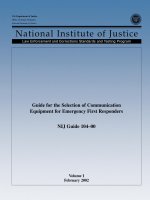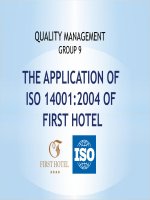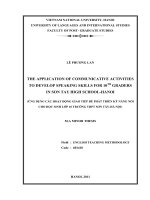The application of silica monolith for solid phase extraction
Bạn đang xem bản rút gọn của tài liệu. Xem và tải ngay bản đầy đủ của tài liệu tại đây (3.11 MB, 155 trang )
THE APPLICATION OF SILICA MONOLITH FOR SOLID
PHASE EXTRACTION
Tarang Nema
(M.Pharm. Sagar University, India)
A THESIS SUBMITTED
FOR THE DEGREE OF DOCTOR OF PHILOSOPHY
DEPARTMENT OF PHARMACY
NATIONAL UNIVERSITY OF SINGAPORE
2011
i
ACKNOWLEDEMENTS
I would like to express my sincere gratitude to my Supervisor, Prof Ho Chi Lui,
Paul for his continuous support and faith he bestowed on me during my PhD
candidature. It was his vision, patience, motivation, enthusiasm, and immense
knowledge that drove me to my final destination. His guidance helped me in
all the time of research and writing of this thesis. I could not have imagined
having a better advisor and mentor for my PhD study, other then him.
Furthermore, I gratefully acknowledge my Co-supervisor, Prof Chan Chun
Yong, Eric, for his advice, supervision and crucial contribution in my research
and so to this thesis. His involvement with his feedbacks had triggered and
nourished my intellectual maturity that I will benefit from, for a long time to
come.
I am deeply grateful for their encouragement, guidance and support.
I would like to express my heartfelt gratitude to Dr. Lin Hai Shu and Ms Wong
Geok Eng for their constant motivation and support that they provided during
the entire process of my research. Their invaluable suggestions and ideas
had guided my research to new heights.
I would like to thank Dr Ng Wai Kiong and Mr. Balani Prashant Nirmal,
Institute of Chemical Engineering and Chemical Sciences for their kind
support with surface area analysis. I am also thankful to technical assistance
provided by laboratory officers, Ms New Lee Sun, Ms Tan Bee Jen, Ms Oh
Tang Booy, Ms Lye Pei Pei, Ms Yong Sock Leng, Mr Sukaman Seymo and
Ms Wong Mei Yin in our department.
ii
I thank my friends to make it a convivial place to work. The formal and
informal support and encouragement from them has been indispensible. I
would like to especially thank, Dr. Meng Huang, Dr. Wang Chunxia, Dr. Rahul
Shukla, Mr Pasikanti Kishore Kumar, Mr. Balani Prashant Nirmal, Mr. Tapas
Ranjan Nayak, Mr. Atul Karande, Mr. Mukesh Saini, Mr. Pradipto Maiti, Mr.
Sudipata Saha, Mr Nikhil Sachdeva, Mr Wang Zhe, Ms Cheong Han Hui, Mr.
Mainak Mal, Mr. Shaikh Mohammed Ishaque, Ms Yang Shili, Ms Kong Sing
Teang, Ms Phua Lee Cheng, Ms Chng Hui Ting and Ms Thiru Selvi for their
friendship that helped me in the past four years. All of them had inspired me in
my research and life, through their useful feedbacks.
It is a pleasure to express my gratitude wholeheartedly to my family for their
support throughout in my life. Words are not enough to express my feeling
towards them.
Last but not least, I thank God for His blessings without which nothing would
have materialized. You have made my life more bountiful. May your name be
exalted, honored, and glorified.
Lastly, I offer my regards and blessings to all those who supported me in any
respect during the completion of my thesis. I would like to thank everybody
who was important to the successful realization of this thesis.
iii
TABLE OF CONTENTS
ACKNOWLEDGEMENT i
TABLE OF CONTENTS iii
SUMMARY vii
LIST OF PUBLICATIONS x
LIST OF TABLES xi
LIST OF FIGURES xiii
LIST OF SYMBOLS xv
CHAPTER 1 Literature review
1.1 Fundamentals concepts of stationary phases 1
1.2 Emergence of the monolithic concept 2
1.3 Monolith: Definition 8
1.4 Monolith advancements 10
1.4.1 Silica monoliths 10
1.4.2 Hybrid monoliths 16
1.5 Applications of monolith 23
1.6 Monolith: as a solid phase extractor 24
1.7 Hypothesis 27
1.8 Research objectives 28
1.8.1 Plan of work 29
CHAPTER 2 Preparation and characterization of silica monolith
2.1 Introduction: Overview of sol-gel technique 30
2.2 Objective 32
2.3 Materials and methods 33
2.4 Experimental 33
iv
2.4.1 Preparation of silica monolith 33
2.4.2 Characterization of silica monolith 33
2.5 Results and discussion 34
2.6 Conclusion 40
CHAPTER 3 Application of Silica Monolith for Catecholamine Analysis
3.1 Introduction 41
3.2 Objective 41
3.3 Materials and methods 41
3.4 Experimental 42
3.4.1 Solid phase extraction 42
3.4.2 Chromatographic conditions 44
3.4.3 Mass spectrometry conditions 44
3.5 Results and discussion 45
3.5.1 Cartridge SPE conditions 45
3.5.2 Adsorption 47
3.5.3 Osmolality 47
3.5.4 Method validation 49
3.5.5 Analysis of spiked urine 51
3.5.6 Extraction efficiency and cartridge carry over 52
3.6 Conclusion 53
CHAPTER 4 Application of Silica Monolith for Ketamine Analysis
4.1 Introduction 55
4.2 Objective 55
4.3 Materials and methods 56
4.4 Experimental 56
4.4.1 Analytical conditions 56
4.4.2 Solid phase extraction 57
v
4.5 Results and discussion 58
4.5.1 Reproducibility of synthesized silica monolith 58
4.5.2 Optimization of LC-MS/MS 58
4.5.3 Evaluation of matrix effect (ME) 59
4.5.4 Analytical evaluation 60
4.6 Conclusion 63
CHAPTER 5 Application of Silica Monolith for Opiates Analysis
5.1 Introduction 64
5.2 Objective 64
5.3 Materials and methods 65
5.4 Experimental 66
5.4.1 Solid phase extraction 66
5.4.2 Testing of the cleaning efficiency of the cartridge 67
5.4.2.1 GC/TOFMS analysis 68
5.4.2.2 LC/MS analysis 69
5.5 Results and discussion 70
5.5.1 Conditioning of the cartridge for SPE 70
5.5.2 Adsorption efficiency of the cartridge 72
5.5.3 Sample cleaning efficiency 72
5.5.3.1 Osmolality 73
5.5.3.2 Sodium content 73
5.5.3.3 LC/MS and GC/TOFMS analysis 74
5.5.4. Method validation 77
5.5.5. Analytes recovery after SPE in urine 79
5.5.6. Extraction efficiency and cartridge carry over 80
5.6 Conclusion 81
CHAPTER 6 Application of Silica Monolith for Desalination
vi
6.1 Introduction 83
6.2 Objective 85
6.3 Materials and methods 86
6.4 Experimental 86
6.4.1 Silica monolith preparation and characterization 86
6.4.2 Membrane charge behavior 86
6.4.3 Desalination test 87
6.5 Results and discussion 88
6.5.1 Surface charge determination 88
6.5.2 Preliminary Study 89
6.5.3 Real sample analysis 91
6.5.4 Silica monolith regeneration 92
6.6 Conclusion 94
CHAPTER 7 Modification in the silica monolith preparation to enhance
the surface area
7.1 Introduction 95
7.2 Objective 96
7.3 Experimental 97
7.3.1 Modified silica monolith preparation and characterization 97
7.3.2 Adsorption study 97
7.4 Results and discussion 98
7.4.1 Characteristics of the compressed silica monolith 98
7.4.2 Adsorption capacity 102
7.5 Conclusion 103
CHAPTER 8 Conclusions and future directions 105
BIBLIOGRAPHY 110
vii
SUMMARY
Silica monolith had been in existence for more than a decade and the
application of this technology for separation had been matured over time. The
application of monolith had been extensively explored for separation in the
form as columns. Although other areas of application have also been
investigated, information of unmodified silica monolith as solid phase
extraction is limited. In this thesis, application of silica monolith for solid phase
extraction had been explored. Basically the thesis had been divided into three
main areas:
1. Application of the prepared silica monolith was realized as a sample
preparation tool for extracting analytes from urine.
The silica monolith was synthesized, characterized and finally tested for
extracting catecholamines (epinephrine, norepinephrine), metanephrine,
ketamine and opiates from urine. The classes of analytes represented
different characteristics. The success in applying the silica monolith in
extracting these analytes reflected the versatility in function of the tested
monolith. For example, catecholamines and metanephrine represented
compounds with highly polar group where as ketamine and opiates
represented compound in the mid polar range. The testing of the silica
monolith with the respective model analytes was described in separate
chapters. Each chapter presented a progression from the previous one and a
constant effort to further refine the process. The preliminary testing (Chapter
3) started with the extraction of catecholamines and metanephrine, the
compounds with high pKa values (>11), and high hydrophilicity. A 2-cm
viii
cartridge was used for extraction, taking urine as a biomatrix. The recoveries
of these compounds after extraction ranged from 59-105% for the three
analytes. The study proved the silica monolith to be effective for solid phase
extraction and the results were encouraging. This led us to explore the
potential of the silica monolith for extracting other compounds to confirm its
diversity in application and the findings were described in Chapter 4. In this
chapter, the batch to batch variation in the preparation of silica monolith was
also investigated. Moreover, the effectiveness of miniaturization was realized
and the cartridge length was reduced from 2 cm to 0.5 cm. The analyte was
extracted from urine and showed recovery around 100%. Thus, a more
extensive study was required to further demonstrate their effectiveness as
solid phase extraction (Chapter 5). This led us to compare their performance
with the commercial Oasis HLB in generating clean extracts. Opiates were
used as a model analytes which again showed the recoveries around 100%.
A full scan LC-MS and GC X QTOF analysis was carried out to demonstrate
the effectiveness of the cartridge in reducing the matrix effect and the results
were compared with the extracts generated from the commercial cartridge,
the Oasis HLB. These studies demonstrated the successful application of
unmodified silica monolith as solid phase extraction.
2. Application of silica monolith in desalination.
The mechanism behind the success of silica monolith as SPE was proposed
to be due to ionic interaction with high surface area. This motivated us to
realize the potential of silica monolith for desalination. Initially, the cartridge
was tested with different concentration of sodium chloride and found effective
in reducing 98% of salt in the samples. This encouraging result led to test the
ix
cartridge for real samples. Thus, sample of seawater from the West Coast,
Singapore was collected and tested for desalination capability of the silica
monolith. Conductivity and osmolality were also determined to check the
quality of water. The cartridge was able to be regenerated using either mild
acid or high temperature at 60
o
C.
3. Finally an attempt was made to improve the surface characteristic of
the silica monolith, especially surface area and pore structures.
To achieve this, the silica monolith was compressed to the desired length
during the aging period. The procured monolith was characterized for surface
morphology using electron microscope, surface area and pore size
distribution using nitrogen adsorption desorption and permeability using back
pressure determination. The observed properties of the compressed silica
monolith were compared to the non compressed monolith to demonstrate the
effectiveness of the technique. The results showed that the surface
characteristics were improved significantly with a compromise in permeability.
Furthermore, the adsorption capacity of the compressed monolith was also
compared to the non compressed one.
This study provided a novel concept of exploring unmodified silica
monolith as a solid phase extractor. The finding in this study may be helpful to
researchers in realizing the potential application of silica monolith in other
areas of analysis, apart from being used as column alone.
x
LIST OF PUBLICATIONS
Journals
• Nema T, Chan ECY, Ho PC. 2010. Application of silica-based monolith
as solid phase extraction cartridge for extracting polar compounds from
urine. Talanta 82:488-494.
• Nema T, Chan ECY, Ho PC. 2011. Extraction of ketamine from urine
using a miniature silica monolithic cartridge followed by quantification
with liquid chromatography tandem mass spectrometry (LC-MS/MS). J
Sep Sci. Article in press.
Conferences
• Oral presentation in PharmSci @ Asia 10 Symposium conducted by
AAPS-NUS in NIPER, India.
• Poster presentation in 2
nd
Separation Science conference held in
Singapore.
• Oral presentation in GPEN 2010 held in North Carolina, USA.
xi
LIST OF TABLES
Table 1-1
Relationship between approaches undertaken to enhance
performance versus the parameters affected.
4
Table 1-2
Comparison of the physical and surface properties of a
particle column (Symmetry C
18
, Waters) and a monolithic
column (Chromolith Performance RP-18e, Merck).
10
Table 3-1
Optimized parameters for LC/MS quantitation.
44
Table 3-2
Linearity range, LOD and correlation coefficient of analytes
in aqueous solution.
51
Table 3-3
Interday and intraday variation of analytes in aqueous
solution.
51
Table 3-4
Interday and intraday variation of analytes in urine.
52
Table 3-5
Relative recovery level of analytes in urine after SPE (n=3).
52
Table 3-6
Relative recoveries of the analytes on a single cartridge
after multiple extractions.
53
Table 4-1
The peak area and RSD value of detected ketamine in
concentration of 20 ng/mL at three different transitions with
three different batches of silica monolith prepared
independently.
58
Table 4-2
Evaluation of matrix effect after multiple extractions on the
same cartridge.
60
Table 4-3
Linearity range, LOD and LOQ data of ketamine at three
different transitions.
61
Table 4-4
Recoveries with RSD values of ketamine after multiple
extractions from urine samples.
61
Table 4-5
Intra- and inter-day variations in the determination of
ketamine in urine samples.
62
Table 5-1
Optimized parameters for LC/MS quantitation.
70
Table 5-2
LOD, LOQ, linearity range, and the correlation coefficient
for the calibration curve of the respective analytes.
78
Table 5-3
The precision of the assay in intra- and inter-day variation
79
xii
of the analysis in urine samples.
Table 5-4
Recoveries of analytes from urine samples after SPE
(n=3).
79
Table 5-5
Recoveries of the analytes on a single cartridge after
multiple extractions.
81
Table 6-1
Measurement of Sodium content before and after cartridge
passed (CP), NaCl solutions in the concentration range
from 10,000-40,000 ppm.
90
Table 6-2
Efficiency in the desalination process indicated by the
variations in sodium c
ontent measurement after multiple
extractions with the same cartridge at different
concentrations of the NaCl solution.
90
Table 7-1
Surface characteristics of the prepared silica monoliths.
102
Table 7-2
Adsorption capacity of the prepared silica monoliths.
103
xiii
LIST OF FIGURES
Fig. 1-1
van Deemter curve indicating the optimum velocity at
maximum efficiency.
2
Fig. 1-2
Summary of monolith emergence.
6
Fig. 1-3
General scheme of monolith preparation via sol-gel method.
12
Fig. 1-4
Monolith preparation using mixed monomer via Sol-gel
method.
14
Fig. 1-5
Schematic representation of alkoxysilane modification to be
used in materials syntheses.
21
Fig. 1-6
General scheme for preparation of molecular imprinted
monolith.
22
Fig. 2-1
Steps involved in silica monolith preparation.
31
Fig. 2-2
Nitrogen adsorption desorption isotherm and pore size
distribution of the prepared silica monolith.
36
Fig. 2-3
XRD pattern of the prepared silica monolith.
37
Fig. 2-4
SEM images and EDX spectra of the prepared silica
monolith.
38
Fig. 2-5
TEM photographs of the prepared silica monolith.
39
Fig. 2-6
FTIR spectra of the prepared silica monolith.
40
Fig. 3-1
Extraction steps using the prepared underivatized silica
cartridge on SPE manifold.
42
Fig. 3-2
Mechanism of adsorption and desorption of analytes in SPE.
45
Fig. 3-3
Fig. 3-4
Comparison of the osmolality of the urine samples (n=3)
before and after SPE: (1) Osmolality of the pure extracting
solvent; (2), (3) and (4) are the osmolalities of the blank urine
samples collected at different time points before and their
extracts after SPE.
LC MS/MS chromatograms of Epinephrine (A),
Normetanephrine (B) and Metanephrine (C) at a
concentration of 50 ng/mL
48
50
Fig. 4-1
LC MS/MS chromatograms of ketamine obtained at three
62
xiv
different transitions, namely 238→125 (A), 238→179 (B) and
238→163 (C).
Fig. 5-1
The structures of opiates along with pKa and compounds are
numbered based on their elution order.
66
Fig. 5-2
Comparison of the osmolalities of water with urine samples
before and after SPE with silica monolithic cartridge and
Oasis HLB cartridge; (I), (II) and (II) are the measurements
from different experiments.
73
Fig. 5-3
Full scan LC/MS chromatogram of urine sample (top) and
eluent after SPE (bottom) obtained from the respective silica
monolith (left) and Oasis HLB cartridge (right).
75
Fig. 5-4
GC/TOFMS full scan chromatograms along with the number
of peaks present in urine samples before and eluent after
SPE with the respective silica monolithic (top)
and Oasis
HLB cartridge (bottom).
76
Fig. 5-5
LC/MS/MS chromatograms of the blank urine samples (A1),
(B1) and (C1) and the corresponding urine samples spiked
with 100 ng/mL of morphine (A2), codeine (B2) and cocaine
(C2) following SPE with the prepared
silica monolithic
cartridge.
77
Fig. 6-1
Effect of NaCl on zeta potential of silica monolith.
89
Fig. 6-2
1. Osmolality of pure water; 2. Osmolality of seawater before
and after cartridge passed.
91
Fig. 6-3
1. Conductivity of pure water; 2. Conductivity of seawater
before and after cartridge passed.
92
Fig. 6-4
Effect of temperature on the zeta potential of silica monolith.
93
Fig. 7-1
SEM images of the prepared silica monoliths.
100
Fig. 7-2
TEM images of silica monolith. (A) 0% compressed; (B) 50%
compressed
101
Fig. 7-3
Effect of compression on the permeability of the silica
monolith
102
xv
LIST OF SYMBOLS
HPLC
High performance liquid chromatography
SPE
Solid phase extraction
MS
Mass spectrometry
MS/MS
Tandem mass spectrometry
ESI
Electrospray ionization
QTRAP
Hybrid triple quadrupole linear ion trap
FTIR
Fourier transformed infrared
MRM
Multiple reaction monitoring
CUR
Curtain gas
GS1
Ion source gas 1
GS2
Ion source gas 2
TEM
Source temperature
DP
Declustering potential
CE
Collision energy
EP
Entrance potential
CXP
Collision exit potential
SEM
Scanning electron microscope
TEM
Transmission electron microscope
XRD
X-ray diffraction
EDX
Energy dispersive X-ray
BJH
Barrett–Joyner–Halenda
BET
Brunauer–Emmett–Teller
CHAPTER 1
Literature Review
Chapter 1 1
1.1 FUNDAMENTAL CONCEPTS OF STATIONARY PHASES
Stationary phase is the heart of each chromatographic system, whether
employed as columns for separation or as extraction cartridges for sample preparation,
and its performance determines the efficiency of the chromatographic process.
Nevertheless, sorbents used for extraction, as in SPE, or separation, as in HPLC, work
on the same principle but differ in chromatographic properties to achieve the
respective goals. HPLC typically depends on numerous cycles of sorption and
desorption in order to separate the analytes with good resolution. Whereas extraction
depends on the sorption of analytes which is to be selective and strong in order to
isolate the analytes from the interfering matrix and finally desorbing the analytes
completely using a suitable solvent. The stationary phase is encased either inside an
inert plastic or stainless steel holder in the shape of hollow straight rod, syringe barrel
or disk depending on the desired application. Conventionally, chromatographic
column is packed with porous silica microparticles, the size of which ranges from 2-
10 µm when used for separation and from 50-60 µm when used for extraction. The
column performance is commonly described by van Deemter equation which is given
by:
H = A + B/µ + Cµ
where,
H or HETP = height equivalent to a theoretical plate
µ = linear velocity
A term is a measure determined by eddy diffusion/interparticle channels; it is particle
size dependent and velocity independent.
B term is a function influenced by molecular diffusion axially; it is inversely
proportional to velocity.
Chapter 1 2
C term is a function of the mass transfer kinetics; it is directly proportional to velocity
and particle size.
These three terms A, B and C influence each other and give a function that can be
represented by the typical van Deemter curve (Figure 1-1); and predicts the band
broadening and the overall performance of the column. The HETP curve shows a
minimum at a particular velocity, which is postulated to be the optimum velocity. At
the optimum mobile phase velocity, the column will provide a maximum number of
theoretical plates, i.e., the highest resolution power.
Fig. 1-1. van Deemter curve indicating the optimum velocity at maximum efficiency.
1.2 EMERGENCE OF THE MONOLITHIC CONCEPT
Because of the paramount importance of the column in the separation science,
instrumentation of a separation system is designed and optimized around the column
and aims at facilitating, preserving and enhancing the separation performance of the
column. Plenty of research has been carried out in developing highly retentive and
selective column with the prospects of resolving components in a short duration and
cost-effective manner. Faster analysis time is the driving force in chromatographic
B term
Liner Flow
A term
Optimum Velocity
C term
HETP
Chapter 1 3
process and to achieve it, various approaches had been taken into consideration. One
of the simplest approaches is the column operation at higher temperature. Increase in
temperature decreases solvent viscosity effectively, allowing flow rate to increase
markedly due to reduced back pressure which finally reduces analysis time. In
addition, increasing temperature also enhances analyte mass transfer which
contributes to increased separation efficiency. Although elevated temperature had
been shown to have potential, it is limited by the thermal stability of analytes and
stationary phases. Boiling point of solvents also limits the operation at elevated
temperature. Another common approach is reduction in column length. It is
acceptable until column efficiency remains satisfactory for separation. Column length
is also directly related to backpressure, longer the column gives higher the back
pressure and vice versa. Hence, to achieve higher efficiency with shorter analysis
time, the approach of reducing column length is coupled with the reduced particle
size. The particle size reduction is the significant approach which enhances efficiency
manifolds due to the enhanced surface area which favors rapid mass transfer.
However, it is limited due to increased backpressure as it is inversely related to
particle size. Therefore traditional approaches to obtain column having ideal
characteristics are still under progressive investigation. Table 1-1 depicts the
relationship between approaches to enhance the performance against the properties of
the column.
Chapter 1 4
Table 1-1. Relationship between approaches undertaken to enhance performance
versus the parameters affected.
Approaches
Affecting
Parameters
Particle size reduction
(dp)
Column
length
(L)
Column temp.
(T)
Analysis time
Not related
∝ L ∝ 1/T
Column efficiency
∝ 1/dp ∝ L
Barely change
Backpressure
∝ 1/dp
2
∝ L ∝ 1/T
Furthermore, miniaturization in column is a trend in column technology in
recent years. Miniaturization of column in analysis irrespective of the applications
(e.g., proteomic, metabonomic, and environmental analysis) or any fields of science
for separation and quantitation has the advantages of: (1) less solvent consumption,
leading to lower cost of analysis in terms of lower cost of purchase of solvent and its
disposals; (2) more environmental friendly and finally; (3) adding more sensitivity to
the analysis [Saito et al., 2004; Legido-Quigley et al., 2002]. However, the limited
loading capability and more sophisticated instrument requirements to achieve the
desired flow rate and detection, limit their applicability.
Chromatographic resolution is based on the size and distribution of the
particles along with the quality of packing. Higher column efficiency and shorter
analysis time are the key factors that every chromatographer desires. Performance of
particulate columns also depends on the frit that is placed at the end to retain particles
within the column [Siouffi, 2003]. Ideally, the frits should be porous enough to allow
uniform flow of mobile phase through the column which is difficult to achieve. This
Chapter 1 5
leads to certain drawbacks in particle packed column. Conventional frits for
microbore column, specially utilized in capillary electrochromatography (CEC) and
micro HPLC, are usually prepared by sintering technique that utilizes very high
temperature. Heat generated in the process can lead to destruction of stationary phase
which can hamper the column performance and efficiency of separation. Bubble
formation and analyte reaction with the frit material are some other problems
associated with the end frits that cause deterioration of the column performance. Thus,
a lot of skill and experience is required to reproducibly prepare a highly permeable
and robust end frits.
Flow of mobile phase through the particle packed column depends on the
permeability of the packed bed. This permeability is based on the size of particles and
their distribution along with the quality of packing. Small particle (< 2 µm) packed
columns result in faster separation and better resolution due to smaller eddy diffusion
and shorter path length. Further decrease in particle size for enhanced performance at
higher flow rates is restricted due to increased back pressure (as pressure is inversely
proportional to square of particle diameter, according to Darcy’s law) [Siouffi, 2003].
To achieve high separation efficiency with these columns, ultra high pressure liquid
chromatography (UPLC) [MacNair et al., 1997; MacNair et al., 1999] and capillary
electrochromatography (CEC) [Dittmann et al., 2000; Dadoo and Zare, 1998] have
been employed. Although these instruments solve the problem to certain extent, their
machine cost is high, for example UPLC requires high tensile strength expensive
alloys. Design development, initial investment and maintenance cost are some of the
major issues that limit their accessibility to the common users.
In light of the above concerns on particulate column, the need for efficient,
uniform structured and porous fritless surface active column is desired, and it can be
Chapter 1 6
prepared easily and is economical. These desired properties have been found to be the
characteristic features of monolithic columns. The concept of monolithic columns was
first conceived in the late 1970s when the scientists tried to use some organic
monomers to prepare monolithic columns primarily to separate proteins [Kubin et al.,
1967]. In recent years, monolithic stationary phase has gained high acclamation and
myriad of research has been carried out. Figure 1-2 shows a schematic of monolith
development in analytical science. The work has recently been reviewed by Cabrera
[Cabrera, 2004]. It is because of their ease in preparation, efficient properties and
excellent performance compared to conventional packed columns which make them
an efficient tool in HPLC [Szumski and Buszewski, 2007]. According to Zou et al.,
monolithic stationary phase is a continuous unitary porous structure prepared by in
situ polymerization of monomers (organic/inorganic) inside the column tubing [Zou et
al., 2002; Gusev et al., 1999].
Fig. 1-2. Summary of monolith emergence.
Uniformity of bed with no end frits involved, higher permeability, convenient
modification to desired chromatographic stationary phase (hence called as surface
Urged the need for
column which are :
• Efficient
• Uniform
structured
• Fritless
• Porous
•
↑
Permeability
↓
Back pressure
• Modified to
desired chemistry
• Design to desired
length
MONOLITHS
Column
technology
advancements
Operation at
↑
temperature
↓
Column
length
↓
Particle size
Column
Miniaturization
Limitations
• Analytes and stationary
phase thermal instability
• Solvents boiling point
• Compromised
column efficiency
•
↑
Back pressure
•
↓
Loading capability
• Sophisticated
instrument
requirement
Chapter 1 7
active monolith) and fabrication to desired length are the main advantages of
monolithic stationary phase. There are various ways of preparing a monolith. Some of
the most common approaches for their preparation include (1) polymerization of
organic/inorganic monomers of different chemical properties, (2) fusion of
microparticles with the monolith inside the capillary by sintering and (3) usage of
hybrid material [Siouffi, 2003]. Monolith based on organic monomers were the first
and the most worked-on area in the chromatographic research, but the problems of
swelling of polymers in some solvents and mechanical instability limit the use of
organic monomers as monolithic stationary phase. These problems associated with
organic monolith led to the introduction of inorganic based monoliths using
monomers like, tetramethoxysilane, tetraethoxysilane and other functional monomers
or combination monomers. These inorganic monoliths have the advantages of high
mechanical stability and resistance to swelling in solvents when compared to organic
monoliths [Motokawa et al., 2002; Minakuchi et al., 1996; Hjerten et al., 1989].
Another technique of fusing microparticles by sintering is one of the uncommon
approaches for preparing monolithic columns. The approach had limited application
due to the two major hindrances, first, difficulty in preparation and second,
inconsistent column performance [Asiaie et al., 1998; Adam et al., 2000].
There are plenty of advantages associated with monolithic column which
make them an efficient and promising tool in the separation technology, but due to
some other disadvantages, the monoliths still has limited popularity as a stationary
phase. Cracking and shrinkage of the formed rod inside column tubing and difficulty
in housing the detached rod in suitable cartridge are the major drawbacks of
monolithic column [Siouffi, 2003]. These pose as challenges in research on
developing monolithic columns.
Chapter 1 8
1.3 MONOLITHS: DEFINITION
In chromatographic terms, monoliths represent a continuous single rod of
porous material [Tanaka et al., 2002]. It is characterized by high permeability due to
uniform distribution of macropores and mesopores throughout the network enabling
separation of many analytes. The macropores present provide the permeability for
solvents to flow through, whereas mesopores provide the high surface area for
separation. As the formed network fills the column volume completely, inter-
particulate voids are absent, resulting in 100% flow of mobile phase through the
column. For the preparation of monolithic column, the need for packing, as in particle
packed column, is unnecessary, as the monolith can be prepared in situ by
polymerization. However, this process of polymerization is restricted to capillaries
(usually less than 200 μm in internal diameter, ID) due to the problem of shrinking of
monolith in the capillaries or column of larger ID. A comparison of the physical and
surface properties between a particle packed column and a monolithic column is
shown in Table 1-2.
Monolithic columns are easier to prepare, to the desired porosity and pore
diameter to suit different needs [Qin et al., 2006]. Specific selectors such as chiral
selectors can be incorporated in the monoliths and kept in place through co-
polymerization. The elution time can be reduced by a factor of 5 to 10 in comparison
to particulate column [Ro et al., 2006]. No special skill is required in all these
procedures, making inter-laboratory studies easy and comparable [Szumski and
Buszewski, 2007]. There is also a decrease of risk of bubble formation or breakage of
the capillary [Qin et al., 2006], as the column backpressure is lower under higher
mobile-phase flow rates [Ro et al., 2006].









